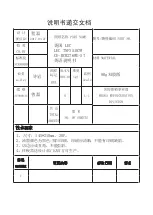
Translation of the original instructions
ENGLISH 3
3
General reccomendations, reception and disposing of unit
INTENDED USE
This appliance is designed for indoor use and
should only be used to store food.
Conservation models (low temperature) have
been realized to store only pre-frozen products.
Never place liquids or hot food into the appliance
and do not fill lidded containers to the top.
Do not store explosive substances such as
aerosol cans with flammable propellant in this
appliance.
They may explode.
In all appliances there are surfaces subject to
frosting. Depending on the model, frost may be
melted away either automatically (automatic
defrost) or manually. Never attempt to remove
frost
using
a
pointed
object
You could irreparably damage the appliance.
Do not use any mechanical device or other
artificial means to accelerate the defrost process.
The Manufacturer declines all responsibility, and
the warranty shall be null and void, if electrical
and/or mechanical alterations are made to the
product.
HANDLING
BEFORE BEGINNING HANDLING OPERATIONS
ENSURE THAT THE LIFTING CAPACITY IS SUFFICIENT
FOR THE APPLIANCE IN QUESTION
HANDLING with FORK LIFT or SIMILAR
Insert the forks into the side of back of the wooden pallet supplied
with the appliance.
Begin lifting checking that the appliance is in stable equilibrium.
DURING HANDLING OPERATIONS DO NOT TIP OR
TURNOVER
IF
IT’S
NECESSARY
TO
TRANSPORT
APPLIANCE
DIFFERENTLY
AS
IN
ITS
WORKING POSITION, YOU HAVE TO WAIT AT
LEAST 2 HOURS BEFORE OPERATING.
KEEP DRY
STACKING OF OTHER OBJECTS ON THE APPLIANCE
MUST BE ABSOLUTELY AVOIDED.
UNPACKING
Keep the packing out of the reach of children as it could be a danger
hazard.
Dispose of the packing to the specialized collection or recycling
points (respect existing regulations).
Check that the serial number corresponds to the transport
documents.
RESIDUAL RISKS
The refrigerator equipment has been designed
and manufactured with the appropriate devices to
guarantee the health and safety of the user and
does not contain dangerous edges, sharp
surfaces or protruding elements.
The stability of the machine is guaranteed even
when the doors are open; however, do not pull on
the doors.
In the case of refrigerators with drawers, do not
open more than one drawer at a time and do not
lean or sit on an open drawer, so as to avoid
overturning or damaging the refrigerator.
N.B.: In refrigerators with glass doors do not extract
more than one basket or rack at a time so as not to
compromise the stability of the refrigerator.
In case of appliance with wheels, when moving,
take care not to forcefully push the refrigerator so
as avoid overturning and damage. Also note any
unevenness of the surface on which the
refrigerator is being pushed.
ALWAYS BLOCK THE WHEELS WITH THE STOPS
PROVIDED.
NOISE LEVEL
The A-weighted emission sound pressure level at
workstations NOT exceeds 70 dB(A);
DISPOSAL OF UNIT
Our appliances contain the refrigerant shown on the
corresponding rating plate as per Regulation (EC) No.
2037/2000 of 29 June 2000; in addition, the appliance is
composed of reusable or recyclable parts and materials.
Therefore, at the end of its lifetime, the appliance should be
delivered to a specific disposal center.
The best method to ensure that no one will remain trapped
inside is to take off the door completely.
The appliance must not be disposed of together with
household waste and metal scrap.
Absolutely avoid damaging the refrigeration circuit,
particularly near the heat exchanger.
COMPLY WITH LOCAL REGULATIONS
IN FORCE CONCERNING THE FINAL
DISPOSAL OF THIS TYPE OF
EQUIPMENT
.
Summary of Contents for KU 1425
Page 46: ...45 45 2 70 A 2037 2000 29 2000...
Page 47: ...46 46 R290 50 0 5 5 50 2 6 16A ON STAND BY 1...
Page 48: ...47 47 6 UNLOCK ESC STANDBY 1 1 30 15...
Page 49: ...48 48 16 business economy Nascondi Barra E S 24 149 HACCP HACCP...
Page 51: ...50 50 R290 13 2 8 1 3 50...
Page 58: ...57 57...
Page 59: ...58 58...
Page 60: ...59 59...
Page 61: ...60 60...
Page 66: ...65 65...
Page 67: ...66 66...
Page 68: ...67 67...





































